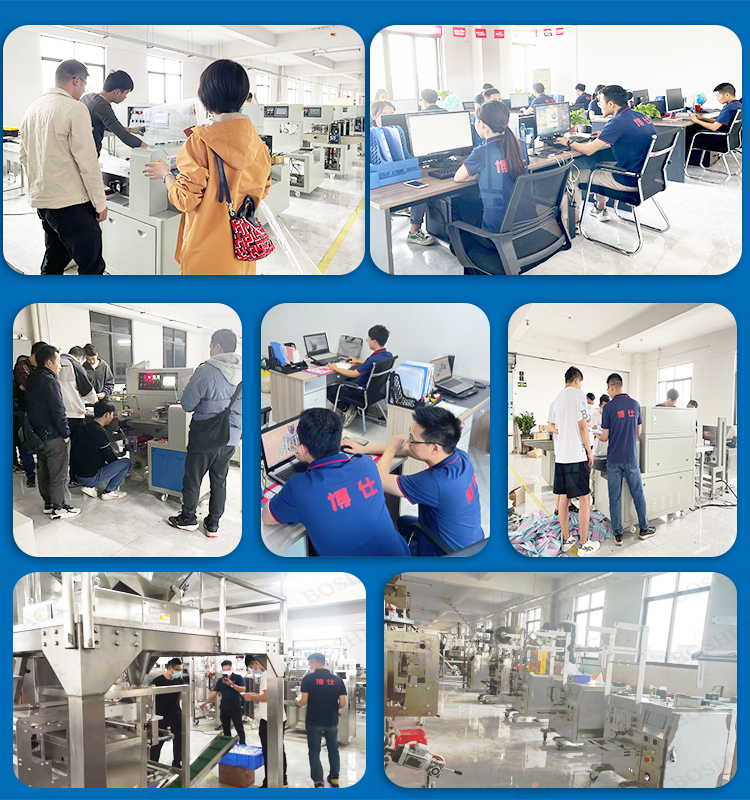1. Full process automation to improve production efficiency
High-speed continuous operation: integrated noodle block directional arrangement, seasoning package sorting, and multi-material synchronous conveying, the production speed can reach 100-300 packages per minute, meeting the needs of large-scale industrialization.
Seamless connection between upstream and downstream: Linked with noodle presses, fried/non-fried production lines, and packaging machines to reduce intermediate stagnation time and achieve "zero breakpoint" production from raw materials to finished products.
Multi-station collaboration: parallel processing of noodle block sorting, seasoning package delivery, tableware package insertion and other processes, the efficiency is 5-10 times higher than manual operation.
2. Accurate material sorting and high packaging consistency
Intelligent positioning system:
Visual recognition: The AI camera detects the posture of the noodle block (such as the front and back, folding angle), automatically corrects the deviation and ensures that the shape of each package of noodle blocks is consistent.
Precise gripping by the robot: Flexible grippers are used for fragile noodle blocks to avoid damage.
Precise delivery of seasoning packages: Photoelectric sensors or weight detection are used to ensure that the type and quantity of each package of seasoning are accurate (such as powder packets, sauce packets, and vegetable packets).
Prevent leakage/wrong loading: Real-time detection of material status in each link, automatic alarm for abnormal situations and rejection of unqualified products.
3. Flexible adaptation to diversified products
Multi-specification compatibility: Quickly switch between different packaging forms such as bag, cup, and barrel through parameter adjustment or mold replacement.
Multi-flavor synchronous production: Supports a variety of seasoning package combinations (such as spicy, pickled cabbage, and seafood flavors), and the material sorting line can automatically identify and match the corresponding noodle batches.
Customized expansion: Additional functions (such as promotional card placement and QR code labeling) can be integrated to meet changes in market demand.
4. Reduce labor costs and operational risks
Reduce manual intervention: Fully automatic material sorting replaces traditional manual sorting and placement, saving more than 70% of manpower.
Reduce defective rate: Automated processes avoid human errors (such as missing seasoning packages and broken noodles), and the product qualification rate is increased to more than 99%.
Safety protection design: The equipment is equipped with protective covers, emergency stop buttons and abnormal warnings to ensure the safety of operators.
5. High hygiene standards and easy cleaning
Food-grade materials: The contact surface is made of stainless steel or food-grade plastic, which complies with HACCP and ISO 22000 certification.
Dust and pollution prevention: The closed conveying channel reduces environmental dust pollution, and the key areas can be equipped with a positive pressure clean system.
Quick cleaning design: The modular structure supports one-click disassembly, and the conveyor belt, trough and other components can be washed with a high-pressure water gun or CIP online cleaning.
6. Intelligent and data-based management
Real-time monitoring system: Track production data (such as output, failure rate, material consumption) through SCADA or MES system to optimize production plans.
Predictive maintenance: Sensors monitor the operating status of equipment (such as motor temperature and vibration amplitude) to warn of potential failures in advance.
Recipe management: Store multiple sets of production parameters (such as noodle block arrangement mode, seasoning package combination), and switch between different product lines with one click.
7. Energy saving and environmental protection
Low energy consumption design: Servo motors and frequency conversion technology adjust power on demand, saving 20%-30% energy compared to traditional equipment.
Reduce the waste of raw materials: accurate measurement and automatic error correction system reduce the loss of noodles and seasoning packets.
Noise control: optimize the mechanical structure to reduce operating noise (≤75dB) and improve the workshop environment.


































